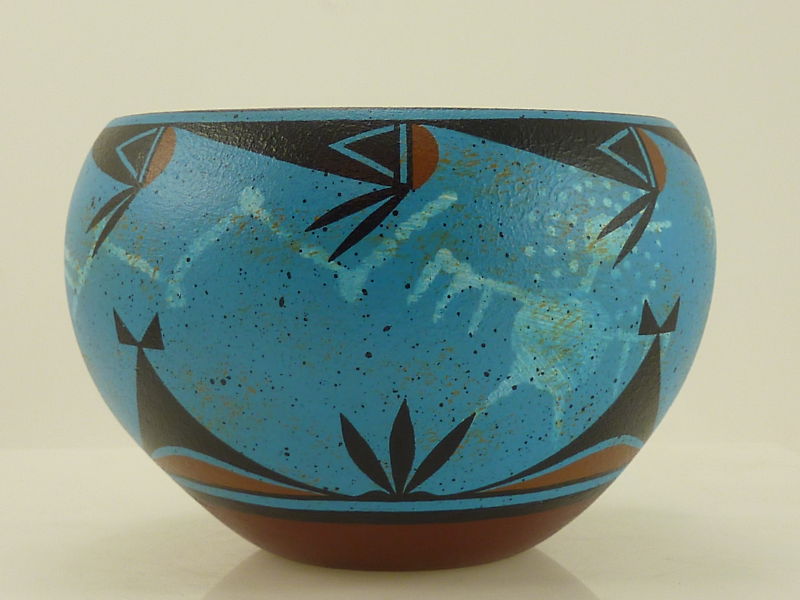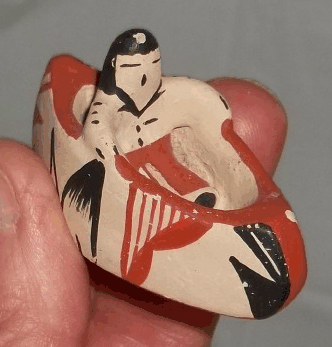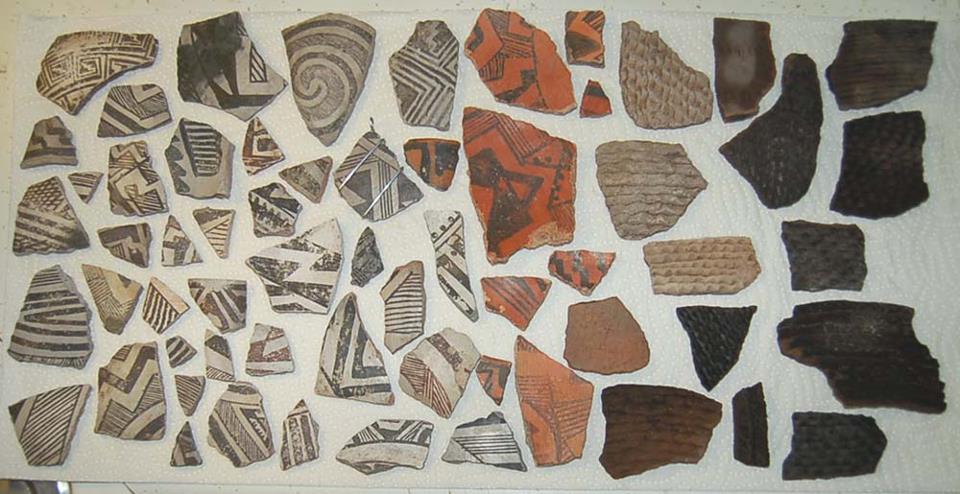
| Noted archaeologist Richard Woodbury once wrote that "everyone's first visit to the southwestern United States is an occasion for enthusiasm, often for love at first sight and lifelong infatuation." Truer words have never been written. I visited the southwest for the first time in 2010, and I fell completely head over heels in love with the Four Corners area. It really was a life changing experience for me, especially since I have long admired the artwork of the southwestern Native American tribes. Of particular interest to me was my visit to Mesa Verde, and after seeing their incredible collection of ancient and modern puebloan pottery, I have become very interested in both. This is my modest collection of modern pottery (along with a few ancient sherds as well). | |
 |
This gorgeous pot is by one of my favorite artists, Ralph Aragon.
He is originally from San Felipe Pueblo, but now lives at Zia
Pueblo with his wife Joan Gachupin. Ralph's pots are unique in
terms of colors and designs, drawing on ancient petroglyphs rather
than traditional Zia designs. (Potters who marry into a different
pueblo usually adopt that pueblo's pottery style.) This piece
was created in 2011 and measures 6" wide by 4" tall.. |
|
Most puebloan pots can be identified by tribe
based on slip color, paint colors, and various painted, sculpted,
or carved design features. This pot, with its creamy yellow slip
and black and red designs, is unmistakably Hopi. It was made by
the well-known Hopi-Tewa artist Patty Maho from Hano village. Born
in 1903, Patty was an active potter from 1930 to 1979. This pot
is thought to date to the 1960s and measures 5" wide by 6"
tall.
|
|
|
Acoma pottery, especially newer work, is likewise distinctive for its bright white slip with complex black and red designs. Fine line work as shown on this small seed pot is very popular. This piece is signed "EC" and was probably made recently, circa 2012. It measures 4" wide by 1.5" tall. |
|
|
This lovely vase is an older Acoma piece by S. Antonio. I believe it dates to the 1950s. It measures 5.25" tall by 3" wide. |
|
|
This gorgeous little pot is classic Zia. It was made by Candelaria Gachupin and bears her distinctive road runner. Not only was she a well-known potter in her own right, but she was also the mother of Joan Gachupin, who is married to Ralph Aragon, the maker of the first pot on this page, and she is also the mother of Dora Tse-Pe, the famed San Ildefonso potter. Candelaria was born in 1908 and died in 1997. She began making pots in the 1930s. This piece probably dates from the 1950s and measures 3" wide by 3" tall. |
|
|
This exquisite, hand-coiled Hopi pot is decorated
in the "migration pattern," a design made famous by Hopi
matriarch Nampeyo. Fittingly, it was made by Rachel Sahmie, a great-great-granddaughter
of Nampeyo. It measures only 2.75" tall by 3.5" wide,
but the fine-line detail is superb.
|
|
|
Santa Clara pueblo potters are famous for their
black-on-black and red-on-red matte and glossy glaze work. Most
of their wares are in the form of pots, bowls, and plates, but black-glazed
miniatures, usually animals, are also popular. This little horse
stands 4" tall and is unmarked.
|
|
|
This beautiful fine line Acoma pot is unsigned. It is tiny, measuring only an 1.25" tall. Here's a shot of the complex pattern on the bottom: |
|
|
This tiny little pot was made by famed Zuni artist Nellie Bica. My grandmother had a much larger heartline deer pot made by Acoma matriarch Marie Chino, and seeing this pot on my shelf always reminds me of the happy times I spent at Grandma and Grandpa's farm. I'm not certain, but I would guess this little pot dates from the 1950s or 1960s. |
|
|
Another teeny pot. It's about the same size as
the deer pot above and was made by Emma Lewis, daughter of Acoma's
most famous potter, Lucy Lewis. I think this pot dates to the 1960s
and measures 1 5/16" wide by 3/4" tall.
|
|
|
This adorable little owl effigy is very tiny,
measuring just over an inch tall. It is signed "R. Chavez,
Acoma, NM," but I haven't been able to identify the artist
yet. I think it's an older piece, probably from the 1970s or earlier.
|
|
 |
This cute little boy in a canoe as a classic Jemez
(pronounced HAY-miss) Pueblo piece. It is marked "Yepa"
on the bottom, but I'm not sure which member of that family made
this piece. I'm not sure how old it is either, maybe 1970s or 1980s?
|
|
This vase is my first non-puebloan Native American
piece. It was made by Kate Dismounts of the Lakota Sioux tribe in
South Dakota. I think it was probably made since 2000.
|
|
|
(Click on the picture at left for a larger view.) I purchased all of these pieces from reputable collectors (with documentation) who found the sherds on private land. (Pot hunting is of course illegal on federal and reservation lands.) |
